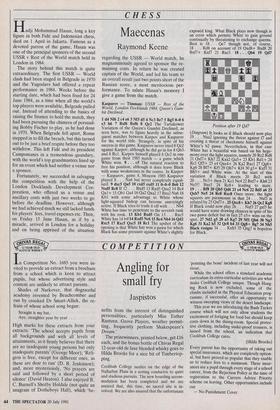CHESS
Maecenas
Raymond Keene
Hadji Mohammad Hasan, long a key figure in both Fide and Indonesian chess, died on 1 April in Jakarta. Famous as a devoted patron of the game, Hasan was one of the principal sponsors of the second USSR v Rest of the World match held in London in 1984.
The story behind this match is quite extraordinary. The first USSR — World clash had been staged in Belgrade in 1970 and the Yugoslays had offered a repeat performance in 1984. Weeks before the starting date, which had been fixed for 24 June 1984, as a time when all the world's top players were available, Belgrade pulled out. Instead of attending to the basics of raising the finance to hold the match, they had been pursuing the chimera of persuad- ing Bobby Fischer to play, as he had done in 1970. When Belgrade fell apart, Rome stepped in to fill the breach, but this turned out to be just a brief respite before they too withdrew. This left Fide and its president Campomanes in a tremendous quandary, with the world's top grandmasters lined up for an event which had neither a venue nor a sponsor.
Fortunately, we succeeded in salvaging the competition with the help of the London Docklands Development Cor- poration, who offered us a venue and ancillary costs with just two weeks to go before the deadline. However, although we had achieved much we still lacked funds for players' fees, travel expenses etc. Then, on Friday 15 June Hasan, as if by a miracle, arrived in London for a holiday and on being apprised of the situation regarding the USSR — World match, he magnanimously agreed to sponsor the re- maining costs. In return he was created captain of the World, and led his team to an overall result just two points short of the Russian score, a most meritorious per- formance. To salute Hasan's memory I give a game from the match.
Kasparov — Timman: USSR — Rest of the World, London Docklands 1984; Queen's Gam- bit Declined.
1 d4 Nf6 2 c4 e6 3 Nf3 d5 4 Nc3 Be7 5 Bg5 0-41 6 e3 h6 7 Bxf6 Bxf6 8 Qc2 The Tartakower Variation of the Queen's Gambit Declined, as seen here, was to figure heavily in the subse- quent matches between Karpov and Kasparov for the world title. Strangely, in spite of his success in this game, Kasparov never tried 8 Qc2 against Karpov, although he did go in [or 8 Qb3. and 8 Rcl. Karpov himself played 8 Qc2 in one game from their 1985 match — a game which White won. 8 . . . c5 The natural reaction to free his position, although it does leave Black with some weaknesses in the centre. In Karpov — Kasparov, game 4, Moscow 1985 Kasparov played 8 . . . Na6 but never completely equal- ised. 9 dxc5 Qa5 10 cxd5 exd5 11 0-0-0 Be6 12 NxdS Rc8 If 12 . . . Bxd5 13 Rxd5 Qxa2 14 Bc4 Qal+ 15 Qbl Qa4 16 Qa2 Qxa2 17 Bxa2 Na6 18 Kbl with some advantage to White whose light-squared bishop can become annoyingly active. If Black tries to trade it off with . . . Nb4 White has time to penetrate to the seventh rank with his rook. 13 Kbl Bxd5 On 13 . . Rxc5 White has 14 b4!14 Rxd5 Nc6 15 Bc4 NM 16 Qd2 Rxc5 17 Rxc5 QxcS 18 Rcl The upshot of the opening is that White has won a pawn for which Black has some pressure against White's slightly exposed king. What Black plays now though is an error which permits White to gain ground continually by threatening to exchange queens. Best is 18 . . . Qe7 though not, of course, 18 . . . Rd8 on account of 19 Qxd8+ Bxd8 20 Bxf7+ Kxf7 21 Rxc5. 18 . . . Qb6 19 Qd7 Position after 19 Qd7 (Diagram) It looks as if Black should now play 19 . , Nxa2 ignoring the threat against f7 and creating a threat of checkmate himself against White's b2 pawn. Nevertheless, in that case White has a beautiful win based on his hege- mony over the light squares, namely 20 Rc2 Rd8 21 Qxf7+ Kh7 22 Kxa2 Qa5+ 23 Kbl Rdl + 24 Rcl Qf5+ 25 e4 Qxe4+ 26 Ka2 Rxcl 27 Qg8+ Kg6 28 Bf7+ Kf5 29 Qh7+ Kf4 30 g3+ Kxf3 31 Bh5+ and White wins. At the start of this variation if Black meets 20 Rc2 with 20 . . . Nc3+ then 21 Kcl Ne4 22 Bxf7+ Kh8 23 Ne5!! Bxe5 24 Rc8+ leading to mate. 19 . . RFS 20 Qb5 Qd6 21 e4 Nc6 22 Bd5 a6 23 Qxb7 Ne5 24 Rc8 Rxc8 Once more, the light squares are paramount in that 24 . . . Nxf3 is refuted by 25 Qxf7+. 25 QxcS+ Kh7 26 Qc2 Kg8 If Black could now play 26 . . . Nxf3 27 gxf3 he would have some drawing chances in spite of his two pawn deficit but in fact 27 e5+ wins on the spot. 27 Nd2 g5 28 a3 Kg7 29 Nn Qb6 30 Ng3 Kg6 31 Ka2 h5 32 Qc8 h4 33 Qg8+ Bg7 34 Nh5 Black resigns 34 . . . Kxh5 35 Qxg7 is hopeless for Black.


















































 Previous page
Previous page